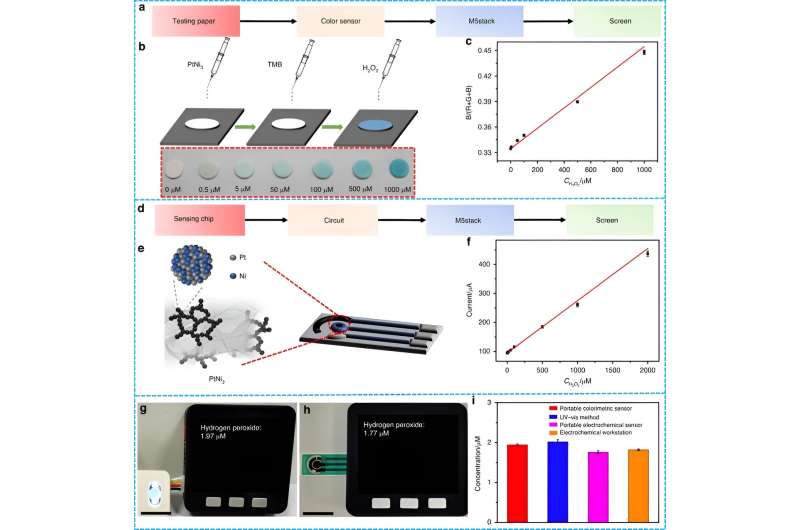This article has been reviewed according to Science X's editorial process and policies. Editors have highlighted the following attributes while ensuring the content's credibility:
fact-checked
peer-reviewed publication
trusted source
proofread
Innovative portable sensors for hydrogen peroxide detection

In a study published in the journal Microsystems & Nanoengineering, researchers from Northwestern Polytechnical University (NPU) have unveiled a breakthrough in the detection of hydrogen peroxide H2O2, a vital biomarker in biological processes, with the development of dual-functional portable sensors based on Pt-Ni hydrogels.
These sensors, adept at both colorimetric and electrochemical detection, are poised to revolutionize personalized health care.
The innovative Pt-Ni hydrogels, synthesized through a simple co-reduction process, are integral to a new method for H2O2 detection. These hydrogels, with their unique structure of nanowire networks and crumpled nanosheets, provide a vast surface area crucial for biosensing. Demonstrating significant peroxidase-like and electrocatalytic activities, they enable both colorimetric and electrochemical sensing of H2O2.
The colorimetric approach involves a visible color change in the hydrogel upon interaction with H2O2, measurable via UV-visible absorption spectra, with a rapid response time. Electrochemical sensing is confirmed through cyclic voltammetry, highlighting the hydrogels' effectiveness in H2O2 reduction.
Key findings include a low detection limit for both colorimetric (0.030 μM) and electrochemical (0.15 μM) methods, wide linearity ranges, outstanding long-term stability of up to 60 days, and excellent selectivity, essential for accurate H2O2 measurement in complex samples.
Additionally, the sensors' performance in detecting H2O2 from HeLa cells aligns closely with standard spectrophotometric and electrochemical methods, confirming their potential for practical applications.
These portable H2O2 sensors represent a significant advancement in the field of health monitoring. Their simplicity, sensitivity, and selectivity make them ideal for point-of-care diagnostics, offering a new avenue for personalized health care.
These devices, with their potential for easy integration into daily life, could revolutionize the way we monitor and manage health conditions, paving the way for broader applications in medical diagnostics and therapeutic monitoring.
More information: Guanglei Li et al, Portable visual and electrochemical detection of hydrogen peroxide release from living cells based on dual-functional Pt-Ni hydrogels, Microsystems & Nanoengineering (2023). DOI: 10.1038/s41378-023-00623-y
Journal information: Microsystems and Nanoengineering
Provided by Chinese Academy of Sciences




















